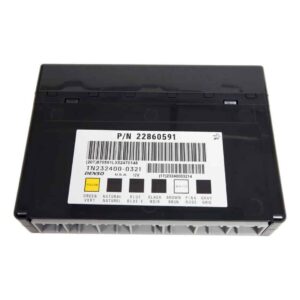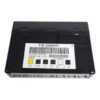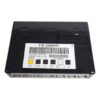Restore Your SUV’s Electrical Brain and End Frustrating Glitches
Is your 2010 GMC Yukon XL 1500 acting possessed? Flickering lights, malfunctioning power windows or locks, and random warning messages on the dash are more than just annoyances—they’re classic signs of a failing Body Control Module (BCM). As the central command for your vehicle’s body electronics, a faulty BCM can make your daily drive unpredictable and frustrating. I’ve spent two decades under the hood, and I can tell you that chasing these electrical gremlins without addressing the root cause is a waste of time and money. This is the direct, reliable solution you’ve been looking for.
This isn’t just a replacement part; it’s a complete fix. We take a genuine OEM BCM and flash it with the latest GM-certified software, specifically programmed to your vehicle’s VIN. This means you skip the expensive trip to the dealership for programming. When it arrives, it’s ready for installation, saving you hundreds of dollars and significant downtime. By providing a properly configured 2010 Yukon XL BCM, we eliminate the guesswork and get your truck’s features working correctly again.
A Technician’s Notebook: The Case of the Confused SUV
A customer brought in a 2010 Yukon XL with a bizarre complaint: the radio would sometimes stay on after the key was removed, the power locks worked intermittently, and the “Service StabiliTrak” light would pop on randomly. They had already replaced the battery and checked the fuses. My scan tool showed a slew of communication codes (U-codes), all pointing to a network issue. Instead of a complex wiring problem, my experience pointed straight to the BCM. It was failing internally, corrupting data packets and causing chaos across the vehicle’s network. Installing a VIN-programmed BCM like this one resolved all issues in under an hour. It’s a textbook example of how a single component can cause widespread, confusing symptoms.
Is Your GM Vehicle Showing These Symptoms?
A failing BCM can manifest in numerous ways. If you’re experiencing any of the following, it’s a strong indicator that your BCM needs replacement:
- ✔ Erratic power window or door lock operation.
- ✔ Interior or exterior lights that flicker, stay on, or don’t work at all.
- ✔ The security or anti-theft system light is on, preventing the engine from starting.
- ✔ Inaccurate gauge readings or a dashboard that goes dark intermittently.
- ✔ Warning messages like “Service StabiliTrak,” “Service Traction Control,” or other system alerts.
- ✔ Diagnostic Trouble Codes (DTCs) such as U0140, U0155, or other communication-related faults.
- ✔ A/C and climate control functions not responding correctly.
A Straightforward Guide to Your BCM Installation
Replacing the 2010 Yukon XL BCM is a manageable job for a confident DIYer. Follow these general steps for a successful installation:
- Safety First: Always disconnect the negative terminal from your vehicle’s battery and wait at least 15 minutes to allow capacitors to discharge.
- Locate the BCM: On most GMT900 platform trucks and SUVs like the Yukon, the BCM is located under the driver’s side of the dashboard, near the steering column. You may need to remove a lower dash panel for access.
- Disconnect the Connectors: Carefully unplug all electrical connectors from the old BCM. They have locking tabs that need to be depressed. Do not force them. Note their orientation for easier reinstallation.
- Remove the Old Module: Unbolt or unclip the old BCM from its mounting bracket and remove it from the vehicle.
- Install the New Module: Mount your new, pre-programmed BCM in the same location and reconnect all electrical connectors, ensuring they click securely into place.
- Reconnect and Test: Reinstall any trim panels you removed. Reconnect the negative battery terminal. Turn the key to the ‘ON’ position (without starting) and test all body functions: lights, locks, windows, radio, etc.
- Perform Relearns (If Needed): Start the vehicle. If an airbag light or other specific warning appears, a post-install procedure like an Airbag System Sync or Brake Pedal Position Relearn may be required using a capable scan tool, as detailed in our included instructions.
Verified Vehicle Compatibility
This module is a direct replacement for a wide range of GM vehicles. Please match your original part number to the list below or confirm fitment for your specific model. This part is compatible with part numbers: 10382479, 15093910, 15276271, 15299986, 15819552, 15828601, 15837419, 15872388, 15872421, 15880684, 15921352, 15921353, 15948438, 15948439, 20815898, 20839063, 20864767, 20864768, 20921435, 20921436, 20935349, 22860591, 25826124, 25826125, 25847588, 25847589, 25892622, 25910474, 25934762, 25934763, 95151084 and fits models including:
AVALANCHE 1500 10
CAPRICE 11-13
CAPTIVA SPORT 12
CTS 08-13
DTS 06-11
ENCLAVE 08-12
EQUINOX 07-09
ESCALADE 10
ESCALADE ESV 10
ESCALADE EXT 10
EXPRESS VANS 08-12
G8 08-09
HUMMER H2 08-09
IMPALA 06-13
LUCERNE 06-11
MONTE CARLO 06-07
OUTLOOK 07-10
SAVANA VANS 08-12
SRX 07-09
STS 10
SUBURBAN 1500 10
TAHOE 10
TORRENT 07-09
TRAVERSE 09-12
VUE 08-10
YUKON 10
YUKON XL 1500 10
Frequently Asked Questions About Your 2010 Yukon XL BCM
Q: Do I really need to provide my VIN?
A: Yes, absolutely. Providing your 17-digit Vehicle Identification Number (VIN) is critical. We use it to load the exact software and vehicle-specific options your Yukon XL was built with. This ensures all features work correctly right out of the box and makes the installation process as smooth as possible.
Q: Is there a core charge? Do I have to send my old BCM back?
A: No. We do not require a core return for this module. You can keep your old part, which saves you the time, cost, and hassle of shipping it back.
Q: What tools are needed for the post-installation procedures?
A: Procedures like the ‘Setup SDM Primary Key in BCM’ (for the airbag light) or the Brake Pedal Position Relearn require a professional-grade bidirectional scan tool. Many local repair shops can perform these relearns for a small fee if they are necessary after installation.
Q: Will this fix my “Service StabiliTrak” warning?
A: A failing BCM is a very common cause of this warning message, as it disrupts communication with the traction and stability control systems. While other issues can cause this light, replacing a faulty BCM often resolves the problem. A proper diagnosis is always the best first step.



